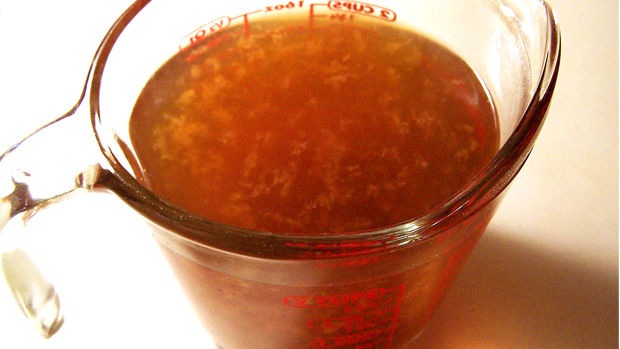
 Stocks are to cooking what Hank Williams is to country music: a source of basic, soulful satisfaction.
Stocks are to cooking what Hank Williams is to country music: a source of basic, soulful satisfaction.
Back when people actually cooked as opposed to simply heating products as they do now, stock played an important role in the kitchen. Stockpots provided a sumptuous basis for an endless variety of dishes; stock is used to make sauces and gravies, soups, stews, and other types of potage. A good stock is the foundation upon which great meals are made. Sad to say, nowadays most people use canned broth or bouillon cubes instead, which is like listening to Reba because you have no Patsy. If you really care about the quality of your cooking, you’ll want to make your own stock instead of having to resort to miserably bland and over-salted alternatives.
Chicken stock is perhaps the easiest and cheapest to make and is good for hundreds of recipes. Whenever I cut up a chicken, I take the wingtips, the back and the neck and store them in the freezer in an airtight container. (If you’re one of those people who buy chicken only as boned and skinned strips of breast flesh in a neat little plastic-covered Styrofoam packages or if you’re too fastidious to cut up a chicken in the first place, don’t even bother.) When I have enough scraps put away, maybe two or three pounds, I’m ready to make stock.
Put such scraps as you’ve accumulated in your designated stockpot; whatever you use should be non-reactive, preferably stainless steel. Add enough water to cover, a couple of stalks of celery, one or two carrots, two onions (all coarsely chopped) two bay leaves, a clove or so of garlic (smashed), a smidgen of thyme and about a handful of roughly chopped parsley, stems and all. Simmer this mixture until the liquid is reduced by at least a half, skimming the scruff off the top as you go. This takes a while; in the meantime, have a beer or two, listen to some Jimmie Rodgers and write Loretta a fan letter.
Then drain off the liquid and return it to the pot. Simmer the stock down until it’s a rich amber color. At this point, it’s not a good idea to add salt because you’re going to season whatever dish you use it in later. When the stock has a good flavor, strain it through a sieve, cool it on the counter for a while, and then set it in the refrigerator to chill. If it’s still warm when you set it in the refrigerator, set it on a rack or put a spoon under the container so air can circulate underneath to cool it quicker, otherwise it might spoil.
Once the stock chills, you’ll end up with a bottom layer of sediment and a layer of jellied stock covered by a layer of yellowish fat. Scrape off the fat with a spoon and store it separately in the freezer for use later to make matzos or potato pancakes. Then carefully spoon out the gel, being careful to avoid as much as the sediment (which should be discarded) as you can, especially if you plan to clarify the stock for consommé or clear soups.
Stock keeps well in the refrigerator for a week or so, but its best just to go ahead and freeze it. Use whatever size container you find appropriate for storing your stock; I’ve heard that some people freeze stock in ice trays and store the cubes in plastic bags, but I suspect people who do this are annoyingly obsessive, since this is a troublesome endeavor, and besides, what if in a moment of absent-mindedness you happen to pop a cube of frozen stock out of the tray and into your scotch and soda? (You might hear the voice of experience speaking here.) Me, I store stock in whatever containers I’ve saved from supermarket products like yogurt and sour cream, pliable ones about pint size with a lid that seals well.
Use it in soups and sauces, or to give more flavor to beans or rice; you’ll notice a big difference. Take stock in your cooking; it pays off.


